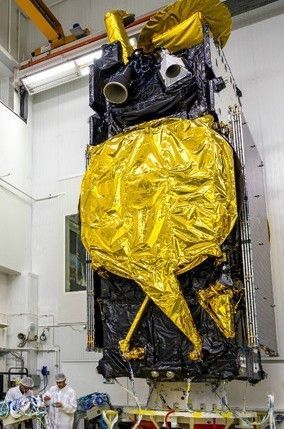When Eutelsat launches EUTELSAT 8 West B later this year, the satellite will be carrying three components that have recently been developed with the support of ESA through the ARTES programme. The mission will provide the new equipment with much-coveted flight heritage status, having proven that it works as intended in the harsh environment of space.
While their development was originally started under the established ARTES 3-4 programme, these three units are of particular interest as they are the first commercial products to be supported under Atlas, a recent extension of ARTES 3-4 that provides assistance in obtaining first flight opportunities for new products. Atlas was established in 2013, and with the upcoming EUTELSAT launch it is now already delivering positive results.
 The expanding 'MENA' market
The expanding 'MENA' market
Responding to thriving demand for digital channels and the growing popularity of high-definition television, EUTELSAT 8 West B will be positioned at 7/8° West and its primary function will be to provide Direct-to-Home TV reception to an estimated 52 million homes in the Middle East and North Africa.
Thanks in part to the newly developed components deployed for the first time with the support of Atlas, the new satellite will raise the bar in terms of performance, flexibility and signal security, Eutelsat said in a recent announcement. The first-flight units include a new-generation flexible frequency converter, a new high-power amplification system system with power and frequency flexibility, and a new frequency-flexible command receiver, all three developed by Thales Alenia Space at its facilities in France and Belgium.
The new frequency converters will give Eutelsat the great advantage of being able to change the frequency of an uplink signal without any impact on the the downlink signal that is received by home viewers. This is a major breakthrough in the prevention of broadcast signals from being jammed by rogue uplink signals.
The new power amplifier, which offers power and frequency flexibility, will optimise distribution of electrical power on the satellite, making it possible for the power used for a channel to be set according to exact requirements. As the number of channels that can be operated simultaneously is directly related to the amount of energy produced by solar panels, this innovation brings with it the potential to increase the number of active channels at a given moment.
Finally, the new frequency-flexible command receiver will give Eutelsat much enhanced operational flexibility, particularly with regard to repositioning the spacecraft to mitigate interference.
Through the Atlas element, ESA has provided support to help obtain a first flight opportunity for these new products; in return TAS and Eutelsat agree to share inflight performance data with ESA.
Tangible results
“Gaining flight heritage for new products is one of the greatest hurdles for suppliers in the highly competitive satcom market, said John Shirlaw, Section Head for Flight Products Heritage and Hosted Payloads at ESA. “Commercial satellite operators are naturally reluctant to use equipment which has not been flown on a satellite. Atlas was established in response to this challenge.”
“We are already observing benefits, even before the Eutelsat launch. For example, other operators see that Eutelsat are planning to use these new products and that gives them the confidence to order these units as well for forthcoming missions,” he said. “This helps ensure their commercial success.”
“We look forward to similar successes with other products in the Atlas pipeline,” said Shirlaw.




